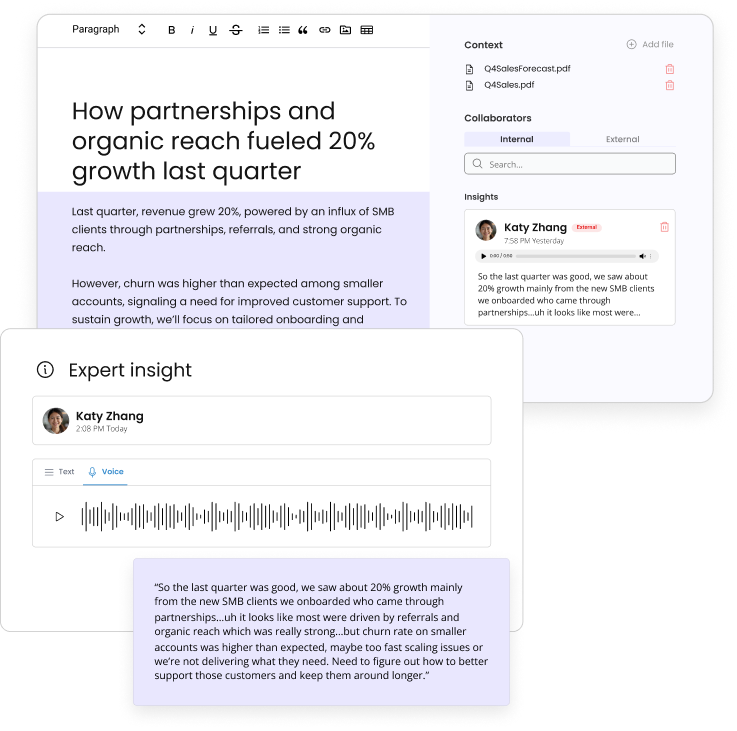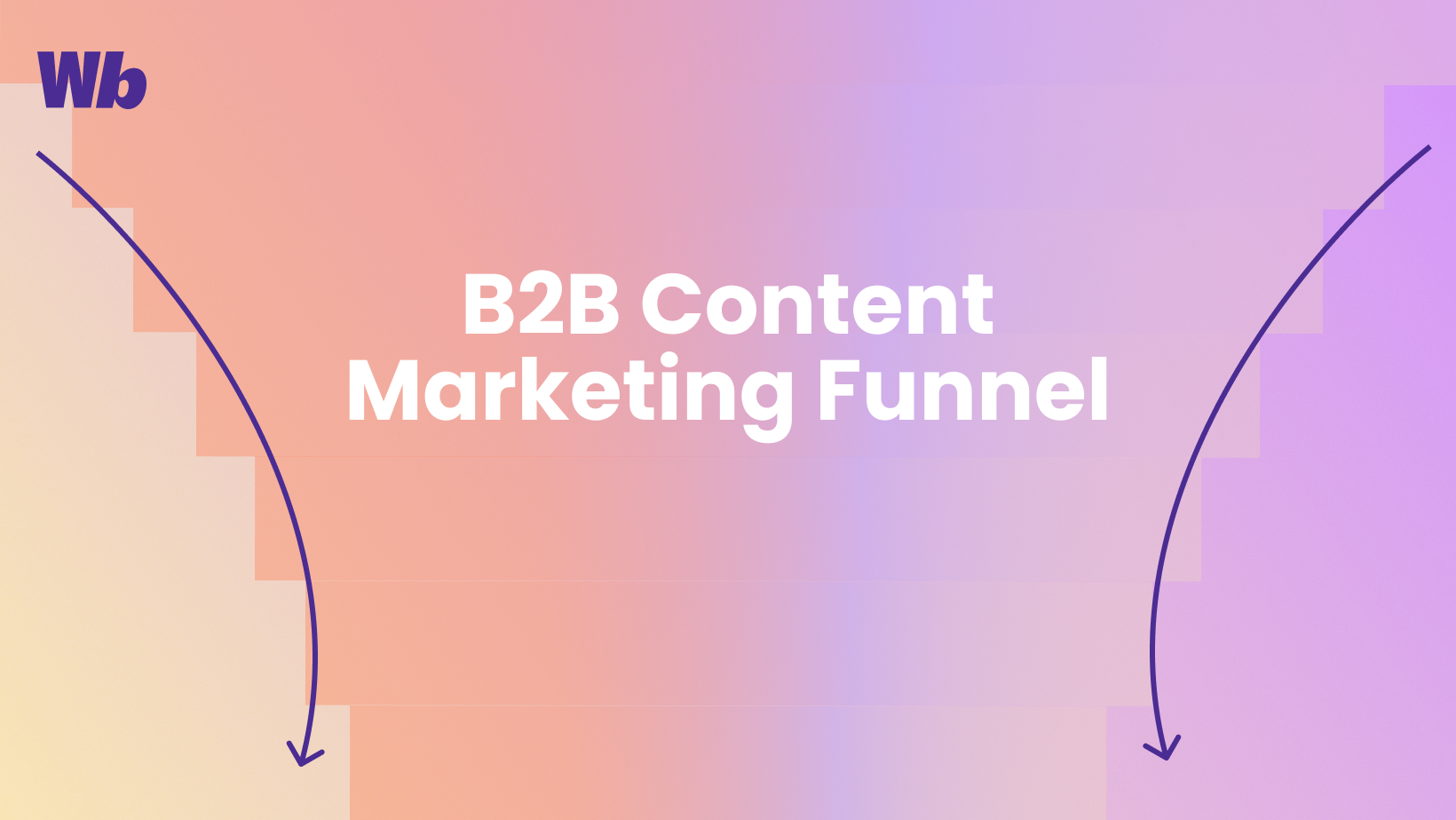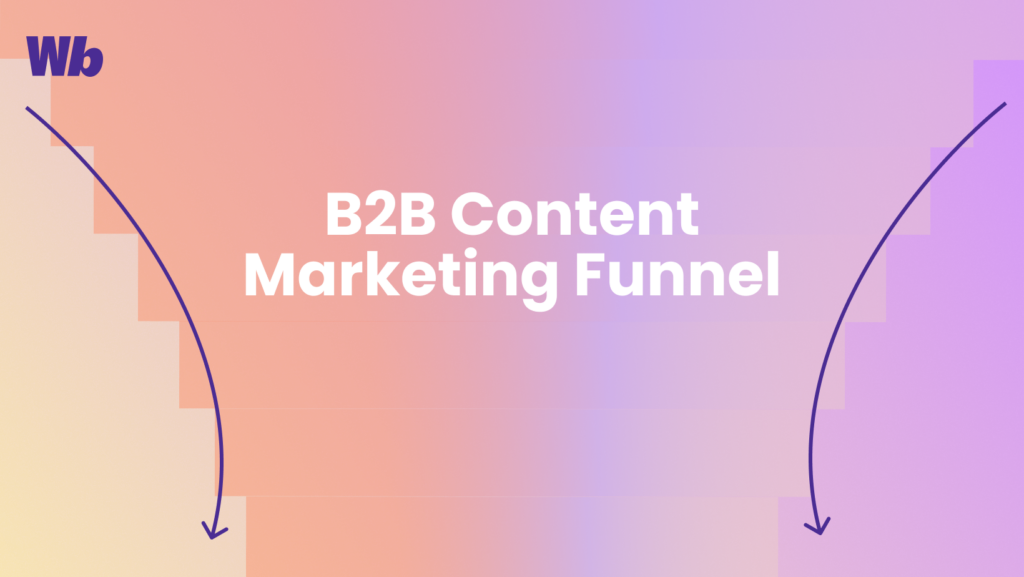Table of Contents

Authority scales when expertise comes first
Wordbrew helps teams collect expert insight before AI ever writes a word.
Built for expert-led, review-safe content
- Home
- »
- Content Marketing
- »
- How to create a B2B content marketing funnel that drives revenue
-
Muhammad Umer
- 11 minutes read time
How to create a B2B content marketing funnel that drives revenue
- Home
- »
- Content Marketing
- »
- How to create a B2B content marketing funnel that drives revenue
How to create a B2B content marketing funnel that drives revenue
Table of Contents

A B2B content marketing funnel is pivotal for guiding prospects through the buying cycle. It creates meaningful engagement, addresses unique challenges at each stage, and ultimately helps to drive conversions.
This framework serves as a roadmap for aligning content marketing strategy with audience needs and business goals.
We’ll further dissect the B2B content marketing funnel, explore its significance, and provide actionable steps to construct a robust sales funnel. Let’s get started.
What to expect
By the end of this blog, you’ll gain a clearer perspective on optimizing your content strategy to foster stronger relationships with your audience and enhance conversion rates.
Understanding B2B and B2C funnels

In this section, we’ll deep-dive into the core concepts of B2B and B2C sales funnels and what they encompass:
Differences in sales cycles
In the business-to-business (B2B) landscape, sales cycles are often longer than business-to-consumer (B2C) scenarios.
B2B transactions involve higher stakes, with decisions impacting entire organizations. This is why the decision-making process is thorough, often requiring approvals from multiple stakeholders.
The result? Sales cycles become longer.
B2B example
Imagine a management software company pitching its product to a large corporation. The decision to purchase affects the entire organization, involving not just the IT department but also legal, finance, and operations.
Multiple rounds of evaluation, negotiations, and approvals are required, expanding the sales cycle to several months or, in some cases, even years.

A survey by DataBox found that 30% of the companies take anywhere between one to three months to close a B2B deal. Another study by Geckoboard came up with the following results:
On the contrary, B2C transactions are straightforward, with individuals making purchasing decisions based on personal preferences. The sales cycles are much shorter, as decision-making is often just based on a single person’s decision.
B2C example
Let’s say you’re shopping online for a new smartphone. You browse various options, read customer reviews, and watch a few video demonstrations.
Within a matter of minutes, you decide to purchase the latest model of your favorite brand.
You add the phone to the cart, enter your payment details, and complete the transaction, all within a 10-minute window.
An average B2C cycle is completed within 5–10 minutes. However, the research process may take anywhere from 15 minutes to a couple of hours.
Target personas
The target personas in B2B and B2C funnels vary significantly.
B2B target personas
In B2B, the focus is on addressing the needs of multiple stakeholders within an organization. Each stakeholder has distinct concerns and requirements, making it essential to tailor content that addresses various angles of a problem or solution.
A B2B content marketing funnel is instrumental in building trust with prospects. It provides a structured pathway, offering valuable insights and solutions to the audience’s challenges at each stage.
This gradual nurturing builds credibility, educates the prospects, and guides them toward making informed decisions.
B2C target personas
In B2C, the target persona is the end consumer. The content in B2C funnels is geared toward addressing individual needs, preferences, and emotions.
It’s often direct and aims to create a personal connection with the individual, evoking a response to make a purchase.
Understanding these fundamental differences between the two target personas is crucial for crafting content strategies that resonate with the intended audience, whether an individual consumer or a stakeholder in a business entity.
Such information assists with content creation, distribution, and measurement, ensuring that the marketing funnel serves its purpose to guide prospects toward informed purchasing decisions.
Benefits of a B2B content marketing funnel
Creating an effective B2B content marketing funnel can be a strategic game-changer for your business. This approach allows you to tailor your message, showcase expertise, and ultimately drive conversions.

Let’s explore the benefits of a b2b content funnel in detail.
Saves costs by providing value for a longer timeframe
A well-constructed content marketing funnel can significantly reduce advertising expenses. It’s a cost-effective method for generating leads and maintaining engagement, reducing the reliance on paid advertising channels.
Several compelling statistics underpin content marketing’s cost-effectiveness:
It generates approximately three times as many leads as traditional marketing methods, yielding a higher ROI.
Providing valuable, informative content attracts and engages potential customers, leading to increased interest and inquiries without the hefty price tag associated with traditional advertising.
Content marketing can also be more cost-effective because one piece of custom B2B content can help countless people learn about your business for months or even years.
Content marketing leverages this by providing consumers with content that resonates, informs, and entertains, increasing customer loyalty and retention over time.
In short, a one-time investment in content production can reap benefits (leads) for years to come.
Increases brand awareness by being present across all fronts
According to the Content Marketing Institute, over 90% of B2B marketers favor content marketing to establish and grow brand awareness over time.
This is because robust and well-crafted content is a powerful tool to position your company as an industry authority and offers your audience a clear insight into what your brand stands for.
Content marketing enables you to spotlight the qualities that are most vital for your audience to grasp. It informs, educates, and provides a direct avenue for your audience to connect with your brand on a personal level.
Suppose you consistently deliver high-quality content through a B2B funnel that resonates with your target audience. In that case, you also position the brand as a thought leader—making it top of mind for prospects seeking solutions.
Establishes authority by addressing industry-specific pain points
A well-crafted content marketing funnel helps in establishing authority in the niche. You can build a reputation for expertise by addressing industry-specific issues and providing expert insights.
Consider it the cornerstone of brand authority involving relevant content tailored to engage a specific audience.
When your brand produces content that addresses your customers’ pain points and interests, you attract and retain their attention.
This, in turn, fosters a perception of authority, setting the brand apart from its competitors.
Thought leadership also entails sharing unique insights, expert opinions, and industry trends through content that goes beyond self-promotion.
Your brand can leverage various content formats across the funnel, such as blog posts, articles, white papers, and social media content, to showcase your in-depth knowledge and contribute to your industry’s advancement.
Boosts organic traffic by providing sheer value to readers
Content marketing boosts organic traffic in a world where traditional advertising is often ignored despite businesses spending billions of dollars annually.
Crafting valuable content that addresses specific audience needs can subtly convey the benefits of your product or service without being intrusive, as traditional ads often are.
This approach seamlessly integrates your offerings into informative and engaging content, making them appear as valuable resources that enhance the information provided.
In turn, this fosters a positive view of your product and service among your audience, which compels them to visit your content the next time they’re looking for a similar solution—hence the boost in organic traffic.
You can boost your organic growth further by:
- Tailoring content to your buyer personas
- Focusing on keywords that resonate with your target audience
- Ensuring that your content is valuable, useful, and relevant
Taking this approach ensures your content gets shared, gains references and inbound links, and ranks higher in search engines, leading to increased organic traffic.
Stages of the B2B content marketing funnel

The B2B content marketing funnel comprises a series of critical stages that guide your audience from initial awareness to the act of becoming loyal customers.
Each stage represents a unique opportunity to engage, educate, and nurture lead generation.
In the following sections, we’ll dive into these stages, exploring strategies, content types, and best practices that will help you effectively navigate the B2B content marketing funnel and drive meaningful results for your business.
Awareness stage
Creating a detailed B2B buyer persona is foundational for this initial stage. This persona acts as a guide to developing content that addresses the specific needs and interests of potential customers.
The primary role of content in the awareness stage is to educate the audience about their problems and introduce them to potential solutions.
It’s about creating a narrative that resonates with the audience, making them realize the need for a solution.
For your company, this translates into crafting a comprehensive B2B buyer persona by uncovering your target customers’ demographics, job roles, and aspirations.
The key here is for your business to gain invaluable insights.
Once you have those, you can tailor your content strategy, messaging, and products to precisely align with what your potential customers are seeking.
How does it translate for your target audience?
From the buyers’ perspective, the business is not just selling a product or service but is also genuinely invested in solving their concerns.
This personalization leads to a more efficient buyer research and decision-making process. It demonstrates that the company understands their concerns and is prepared to provide relevant, valuable solutions to foster trust and loyalty.
Recommended content formats
- Blog posts: Informative articles addressing common challenges faced by the target audience
- Infographics: Visually appealing content to explain complex data or concepts
- Videos: Engaging video content that provides value and educates the audience
- Newsletters: A B2B newsletter with general industry information and latest trends can keep your audience in the loop.
Consideration stage
Prospects actively research to find the best solution. They compare different offerings, read reviews, and seek recommendations.
This means that your content should distinctly showcase the brand’s unique value proposition, explaining why it’s a preferable choice. It’s about building a compelling case that resonates with the prospects’ needs and aspirations.
You can do that by understanding your target audience’s research patterns and preferences and tailoring content to stand out amidst the options.
Doing this will allow your business to form a clear and compelling value proposition, establishing a concrete connection with customers.
How does it translate for buyers?
When companies invest in creating content that distinctly showcases their value proposition, it simplifies the decision-making process for prospects.
The content crafted during this phase offers a roadmap that guides prospects toward making informed decisions, saving them time and minimizing the risk of making a wrong choice.
Nailing this stage creates a win-win scenario where companies stand out, and buyers feel confident that they’re making an educated decision.
Recommended content formats
- Webinars: Offer in-depth insights and a platform for prospects to ask questions
- Case studies: Show real-world examples of how the brand has solved similar problems for other clients
- White papers: Provide thorough insights on specific topics, showcasing expertise
Decision stage
At this critical juncture, prospects are evaluating the final shortlist of solutions. They need reassurance and unmistakable evidence that they are making the right choice.
This is the right time to showcase how your solution outshines the competition and effectively addresses the prospects’ needs.
By doing so, you will instill confidence in prospects, assuring them that they are making the right decision. This reassurance can directly impact conversion rates and drive customer loyalty.
Content plays a pivotal role in facilitating this reassurance. Your content should provide clear, concise information on the features, benefits, and differentiators of the product or service.
It should also ease any concerns and provide a clear path to purchase.
How does it translate for buyers?
From the buyers’ viewpoint, a company’s ability to provide this level of clarity means that the business is genuinely committed to their satisfaction.
It streamlines the final steps of their decision-making process, making them feel informed and confident in their choice, which is critical for a long-lasting, trust-based customer relationship.
Recommended content formats
- Product demos: Showcase the functionality and benefits of the product
- Testimonials: Provide social proof from satisfied customers
- Comparison charts: Offer a clear comparison with competitors, showcasing the unique advantages
In a nutshell, your efforts toward the B2B content marketing funnel will determine how customers ultimately perceive your brand.
The stronger they feel about it, the higher your chances are to make conversions.
On the flip side, failing to deliver the right content at any of the three stages can result in losing prospects to a competitor.
Best practices for creating a B2B marketing funnel that drives revenue

Now that we’ve dissected each phase within the funnel, let’s explore the best practices to optimize each stage for maximum engagement and conversion—constructing a robust B2B content marketing funnel.
- Learn from your audience
Understanding your target audience’s needs, interests, and challenges is fundamental. Create detailed buyer personas to guide content creation and ensure you address the specific issues your audience faces.
For example, consider a B2B software company where an IT manager is tasked with setting up security protocols for the team.
Now, instead of making generic content on “how to establish security protocols for a team,” you can dive deeper to find out where precisely an IT manager struggles.
This can be done through surveys or by finding your audience in communities like Reddit.
Tailor your content to address their precise pain points and make your solution more engaging and effective.
- Plan content for the entire funnel
Mapping content to each stage of the funnel is crucial. For the awareness stage, focus on creating educational content like blog posts.
During the consideration stage, offer deeper insights through webinars or white papers.
Finally, in the decision stage, provide reassurance and clear pathways to purchase with product demos and testimonials.
Let’s take a look at a fitness equipment company as an example. In the awareness stage, your goal is to capture the attention of fitness enthusiasts. Craft informative blog posts such as “Top 10 Home Workouts for Beginners.”
Prospects might seek more in-depth guidance as they move into the consideration stage.
Offer them a valuable resource, like a webinar on “Designing Your Home Gym for Maximum Results” or a comprehensive white paper on “The Science of Effective Home Workouts.”
In the decision stage, when prospects are ready to invest, provide reassurance with product demos showcasing your equipment in action and feature real customer testimonials highlighting their fitness transformations.
A customized content approach ensures you’re effectively guiding potential customers through the marketing funnel, from initial awareness to confident purchasing decisions.
- Analyze content performance regularly
Track and analyze the performance of your content using analytics tools. Measure metrics like engagement rates, conversion rates, and the number of qualified leads generated to understand the effectiveness of your content strategy.
For instance, by tracking analytics, you discover that your white paper generates significantly more engagement and leads than most other content pieces.
The data guides you to create more related content—tailoring your strategy to address what resonates most with your audience and ultimately improving your content’s impact.
- Map channels or touchpoints to funnel stages
Identify the channels where your audience interacts with your content. Adapt your content distribution strategy to ensure it reaches your audience at the right stage of their journey.
In the awareness stage, prospects go after blogs and social media. In the consideration stage, webinars and forums support their research. They seek product demos and testimonials on your website for the decision stage.
You can adjust content accordingly to ensure efficient guidance toward conversion.
- Generate leads and nurture content marketing campaigns
Develop campaigns to generate leads and nurture them through the funnel content. You can create valuable offers to capture leads and develop nurture campaigns to guide them toward a purchase decision.
For example, you can start with a high-value eBook to capture leads, offering it in exchange for contact details.
Then, employ a series of targeted emails, including case studies and webinars, to guide these leads toward a purchase decision and efficiently nurture them through the funnel.
- Optimize continuously to reduce friction
Identify areas in the funnel stages where prospects may be dropping off and work to reduce these friction points.
Continue to optimize your funnel by analyzing performance data and making necessary adjustments to improve conversion rates and overall effectiveness.
For instance, if you identify a drop-off in form-filling for gated content registration, try simplifying the process by redoing the form. It may be lengthy or ask for details that prospects are uncomfortable providing.
On the contrary, if a personalized email marketing campaign increases conversions, stick with it or make slight changes to make the most out of it.
Summing it up
Creating a seamless B2B content marketing funnel is an ongoing process. You have to apply strategies, measure results, and redo those strategies until you find the sweet spot that translates into the highest ROI for your business.
Use the tips and best practices in this article to create the perfect content funnel for your brand.
